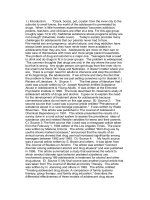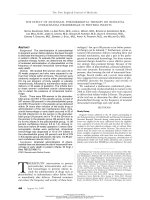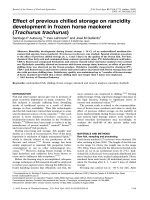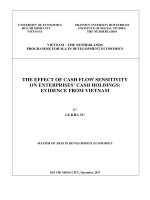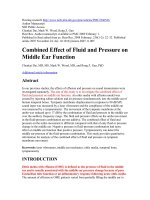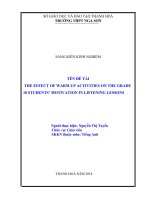Effect of ionic chain polydispersity on
Bạn đang xem bản rút gọn của tài liệu. Xem và tải ngay bản đầy đủ của tài liệu tại đây (2.38 MB, 9 trang )
Macromolecules 1994,27, 5173-5181
5173
Effect of Ionic Chain Polydispersity on the Size of Spherical Ionic
Microdomains in Diblock Ionomers
Diep Nguyen; Xing-Fu Zhong: Claudine E. Williams,'J and Adi Eisenberg**t
Department of Chemistry, McGill University, Montreal, Quebec, Canada H3A 2K6,and
Laboratoire pour 1'Utilisation du Rayonnement Electromagnktique (LURE),
CNRS-CEA-MEN, UniversitB Paris-Sud, 91405 Orsay Cedex, France
Received February 2, 1994; Revised Manuscript Received May 19, 1994'
ABSTRACT: The effect of ionic chain polydispersity on the morphology of spherical ionic microdomains
in the dry state is studied by small-angle X-ray scattering (SAXS) and transmission electron microscopy
(TEM) for two systems of diblock ionomers, polystyrene-b-poly(4-vinylpyridiniummethyl iodide) (PS-bP4VPMeI) and polystyrene-b-poly(cesiummethacrylate) (PS-b-PMACs). The polydispersity of the ionic
blocks is controlled by blending diblock copolymers of constant polystyrene length but different ionic block
lengths. The samples are mixed in appropriate ratios so that the number-averagemolecular weight is constant
but a wide range of polydispersity in the ionic blocks is obtained. The samples are prepared by three different
methods. The first method involves preparation from a solution in which a nonequilibrium state exists. This
is carried out either by addition of a nonsolvent to the single-chain polymer solution (as for the PS-bP4VPMeI series in DMF) or by neutralization in a selective solvent (as for the methacrylic acid copolymers
in THF). In the second method, the PS-b-P4VPMeI samples are cast from a good solvent for both blocks.
Finally, in the third method, the 4-vinylpyridine diblocks are mixed before quaternization and then cast from
THF. Electron micrographs show a regular arrangement of spherical ionic microdomains and ruled out dual
morphology. The radii of the ionic microdomains of samples prepared by methods 2 and 3 are found to
increase linearly with the ionic chain polydispersity, while those which are prepared by method 1stay constant.
This difference is explained in terms of the thermodynamic conditionsprevailing in the solutionsat the onset
of microphase separation.
Introduction
The bulk morphology of ionic AB di- and ABA triblock
copolymers has raised much interest lately.l-1° The strong
incompatibility between the ionic and nonionic moieties
results in the formation of microphases where the local
physical properties (e.g., dielectric constant, solvation, etc.)
are very different. The various morphologies observed
are similar to those of their nonionic counterparts; when
the nonionic blocks are long and the ionic ones are relatively
short, the ionic domains are spherical and dispersed in a
nonionic continuous phase. They act as strong ionic crosslinks, which gives the material very specific mechanical
properties. A broadening of the rubbery plateau and an
increase in the modulus and tensile strength are among
the observed effects?*' These polymers qualify as a special
class of ionomers, the block ionomers, as opposed to the
random ionomers where the ionic units are randomly
distributed along the long nonionic polymer. In these
materials, the ion pairs tend to aggregate in media of low
dielectric constant, and the presence of these ionic
aggregates modifies the properties of the polymer profoundly.lO
The first experimental study of the structure of block
ionomers by small-angle X-ray scattering (SAXS)dealt
with ABA triblock copolymers with a long nonionic
midblock of polystyrene (PS) and relatively short ionic
end blocks of poly(4-vinylpyridinium methyl iodide) .4 In
that study, it was shown that the ionic blocks, even at very
short ionic block lengths, associated into spherical microdomains organized on a highly distorted cubic lattice.
The size of the ionic microdomains was found to be
independent of the PS block length and the ionic blocks
were highly extended. In contrast, the PS chains had a
* To whom correspondence should be addressed.
t McGill
University.
* LURE,
CNRS-CEA-MEN, Universith Paris-Sud.
Abstract published in Advance ACS Abstracts, July 15, 1994.
0024-9297/94/2227-5173$04.50/0
coiled configuration, as shown by small-angle neutron
scattering (SANS).SHigh extension of the ionic sequences
in their microdomains was also reported by Venkateshwaran et aL6 for the methdcrylate-based AB and ABA
block ionomers. More systematic SAXS experiments on
AB and ABA block ionomers8 of short ionic block lengths
of polystyrene-b-poly(viny1pyridinium methyl iodide) or
polystyrene-b-poly(cesiummethacrylate) have confirmed
that the radii are of the same order as the stretched length
of the ionic blocks independent of architecture (AB or
ABA), chemical structure (6vinylpyridinium methyl
iodide or cesium methacrylate), or method of preparation
(casting or molding). The high extension of the ionic chains
has been discussed theoretically by Doi et d . l l when
investigating phase separation of block copolymers in a
superstrong (very large x ) segregation regime.
One puzzling finding of these investigations is the fact
that, in some cases, the radii of the microdomains are larger
than the fully extended chain length. One way of
explaining this fact is to invoke a molecular weight
distribution. Given a molecular weight distribution, it is
possible to envisage the longest chains extending all the
way to the center of the microdomains, with the shorter
chains occupying the regions closer to the surface.
Consequently, the longest chains would play an important
role in determining the radius. Since the studies discussed
above used mostly block copolymers of low polydispersity
(1.1-1.2), only a mild enlargement of the ionic radius with
respect to the ideal monodisperse case is seen.
T o check the validity of this hypothesis, samples have
been prepared with a controlled and increasing polydispersity of the ionic block lengths by mixing different
copolymers with constant PS lengths and various nominal
ionic block lengths in such a way that the average molecular
weights of the sample stay constant; thus, samples with
a wide range of molecular weight distributions are generated. Because reaching thermodynamic equilibrium may
be a problem in these highly incompatible systems,
0'1994 American Chemical Society
